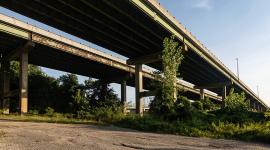Shockoe Hill African Burying Ground Officially Designated as a Cemetery
The ongoing saga of Richmond, VA’s Shockoe Hill African Burying Ground, and its inspiring and indefatigable champion, Lenora McQueen, took an important turn on Tuesday, November 12, when the city council voted unanimously to approve Ordinance no. 2024-283 to designate a city-owned part of the site as an official cemetery. It’s the latest advancement since February 1, 2021 when The Cultural Landscape Foundation (TCLF) enrolled the site in its Landslide program and later featured it in the report and digital exhibition Landslide 2021: Race and Space.
Until the June 12 2022, installation of a historic marker there were no surviving above ground monuments, memorials, or other hints of Shockoe’s former existence; just an abandoned gas station and a billboard.

McQueen, a descendant of Kitty Cary who was buried at Shockoe, wrote to Richmond Mayor Levar Stoney and the billboard’s owner, Lamar Advertising, on July 13, 2024, calling for the sign’s removal; addressing the latter, she concluded: “Billboards do not belong on burial grounds, and your billboard certainly does not belong on this one. The decision to stop desecrating this cemetery should be a simple one. I am asking and hoping that you will do the right thing.” In a letter to the city council TCLF’s President & CEO, Charles A. Birnbaum stated passage of the ordinance was necessary: “to see the site properly acknowledged, protected, and respected. When in active use and after its closure, the Burying Ground suffered a palimpsest of abuse, despoiled over the past two centuries by grave robbers who sold cadavers to the University of Virginia and Hampden-Sydney medical schools (the latter is now part of Virginia Commonwealth University), municipal building projects, highway construction, and other depredations. Today there is little indication of the sacred site that once existed.”
While the ordinance’s passage is an important win, the designation only applies to a 1.2-acre parcel, or roughly four percent of the overall site, which occupied about 31 acres and saw the interment of more than 22,000 freed and enslaved African Americans when it was in active use (1816-1879). In fact, according to a July 5, 2024, Washington Post report: “New archaeological work shows that despite more than a century of desecration by construction and road-building, one of the nation’s most endangered major burying grounds for free and enslaved Africans still contains a significant number of intact gravesites.” The Post noted: “One pylon supporting the billboard — facing a stretch of Interstate 64 also built atop the burying ground — is sunk directly into at least one gravesite and near dozens more.”

According to the Richmonder Lamar Advertising was not opposed to the motion, however “[i]n a written statement to city officials, Lamar reiterated that the billboard is there because the city approved it more than 20 years before asking the company to give it up.” The article continues: “Lamar rebuilt the Fifth Street billboard more than two decades ago with the City Staff's approval of a building permit and direct supervision on site during construction,” the company said in its statement. “We concur with Mayor Stoney when he said in a recent statement in a Washington Post article, ‘the City of Richmond is the only one to blame for this.’” Lamar wants the city to find suitable alternative sites for the billboard.
Mayor Stoney told the Richmond Times-Dispatch: “The Shockoe Hill African Burying Ground has been under assault since its closing in 1879,” adding, “It is time we formally redesignate this sacred space as a cemetery and bring peace to the many souls who rest there.”
In a letter to the city council, McQueen wrote: “the passage of this ordinance will do an incredible thing for this burial ground and provide it much needed recognition and protection in that specific location.” Regardless, she noted of the undesignated section: “the rest of the burial ground remains one of Virginia’s most endangered historic places.”











